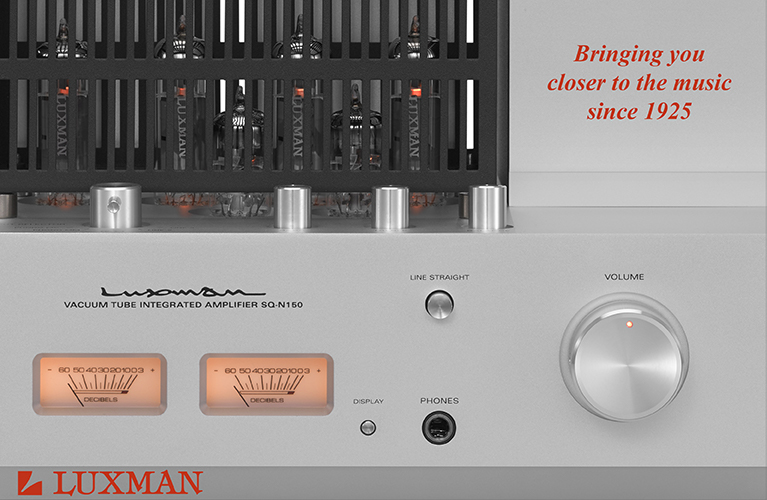 When it was based in Frankfurt, Germany, High End was a typical hobbyist show not unlike the Rocky Mountain Audio Fest -- the industry needs such grassroots hi-fi events. But since moving to Munich a few years ago, High End has been transformed so successfully into an international audio show that this year, when I asked exhibitors if they had to choose between it and the annual Consumer Electronics Show (CES), in Las Vegas, almost all said they’d choose High End, for the large numbers of local and international attendees who turn up. High End Munich is now, arguably, the world’s most significant high-end audio event.
When it was based in Frankfurt, Germany, High End was a typical hobbyist show not unlike the Rocky Mountain Audio Fest -- the industry needs such grassroots hi-fi events. But since moving to Munich a few years ago, High End has been transformed so successfully into an international audio show that this year, when I asked exhibitors if they had to choose between it and the annual Consumer Electronics Show (CES), in Las Vegas, almost all said they’d choose High End, for the large numbers of local and international attendees who turn up. High End Munich is now, arguably, the world’s most significant high-end audio event.
High End 2013 was held May 9-12, and we were there all four days. You can find our on-the-spot coverage on SoundStage! Global, but, as we’ve done for every audio show this year, we’ve saved our “Best of Show” awards for this space.
Here are my picks for the best products and best systems I saw and heard at High End 2013. (Note: Since High End is an international show, the prices cited here are in various currencies. Most are in euros, but some are in US dollars or British pounds, so take note of the currency symbols.)
Best products
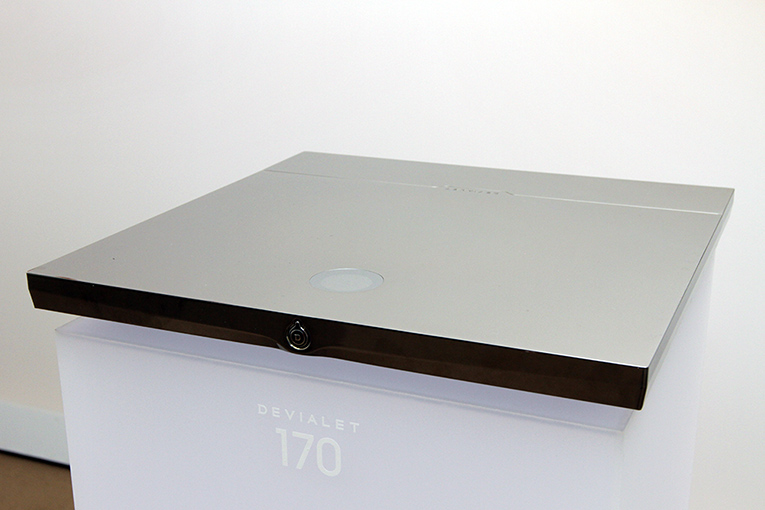
Probably the product introduction most talked about at High End 2013 was a line of amplifiers from France’s Devialet: the 110, 170, 240, and 500. (The model number indicates the power output in watts into 6 ohms.) There are several reasons for the significance of these introductions, but the most important is price. The 110 ($6495) and 170 ($9495) sell for significantly less than Devialet’s original product, the D-Premier ($15,995), and put this amazing amplifier technology within reach of far more consumers. (The D-Premier’s replacement, the 240, costs $17,495.) Other than the new amps’ power ratings and features, they all look similar, and they’re all supposed to sound the same. The various models will appeal to different buyers for different reasons, but I’ll hazard a guess that the 170 will prove most popular, for its combination of price, power, and features. To me, it looks like the sweet spot in Devialet’s new line.
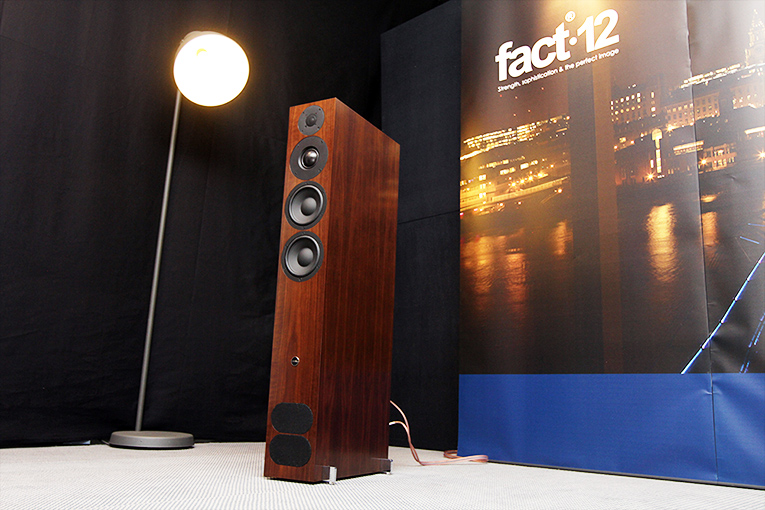
I’ve admired the sounds of many PMC speakers, but I can’t say I’ve liked their looks. It’s hard to come up with a word to describe their appearance, but beautiful isn’t it.
That began to change with PMC’s twenty series, particularly the twenty.24, which I reviewed last year and think has the series’ best combination of size, proportions, and gorgeous real-wood finish -- which, in my opinion, help make it the best-looking PMC of all. The next best is probably the new fact.12, which sells for ₤12,000/pair in the UK (PMC’s home turf), and was shown in Munich.
The fact.12 is a three-way design with a soft-dome tweeter; a dome midrange driver that’s used in PMC’s upper-end speakers (and has won praise) but not in any other fact model, or in the twenty series; and two woofers, augmented in the extreme low end by PMC’s patented transmission-line technology, which they call ATL. What struck me about the fact.12 was first its sound, which was remarkably full in the bass and highly detailed through the mids and highs, but also its appearance -- gorgeous woodwork and a narrow front baffle, just like the twenty.24, with chromed outrigger feet that add just the right amount of pizzazz. PMC is definitely headed in the right direction these days, in terms of the sound and looks of its speakers.
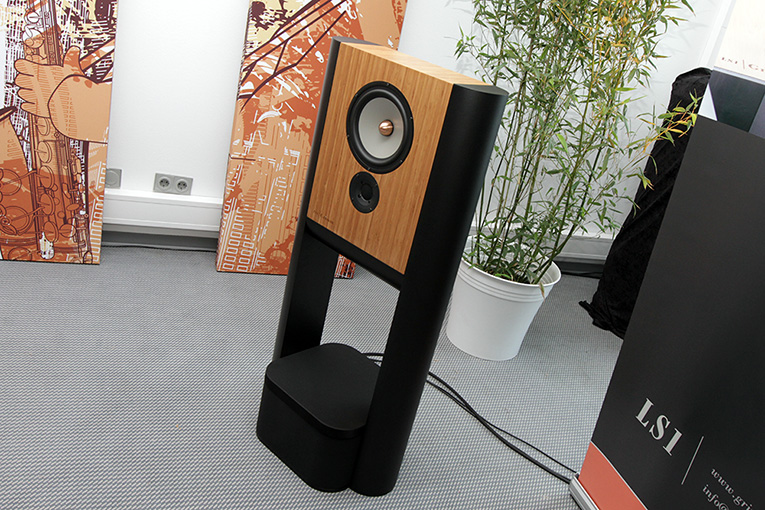
Last March, while attending the Salon Son & Image show, I wrote an article called “Looking-to-the-Future Loudspeaker Designs.” Had Grimm Audio shown there, their LS1, which sells for €21,000/pair, would have been included. Grimm is based in the Netherlands.
The LS1 is a three-way, fully active speaker with a DSP-based crossover and no need for even a preamplifier -- its control unit has a volume control. In Munich it was being fed digital signals from a laptop and from a CD player, but it also has a built-in A-to-D converter, to accept analog signals. The LS1 looks wild: its midrange and tweeter are on a wide baffle with a shallow cabinet behind and its woofer on the bottom, firing straight up. The LS1’s class-D amps are inside. The sound of these speakers was quite something; I talk about that in the second part of this article, below.
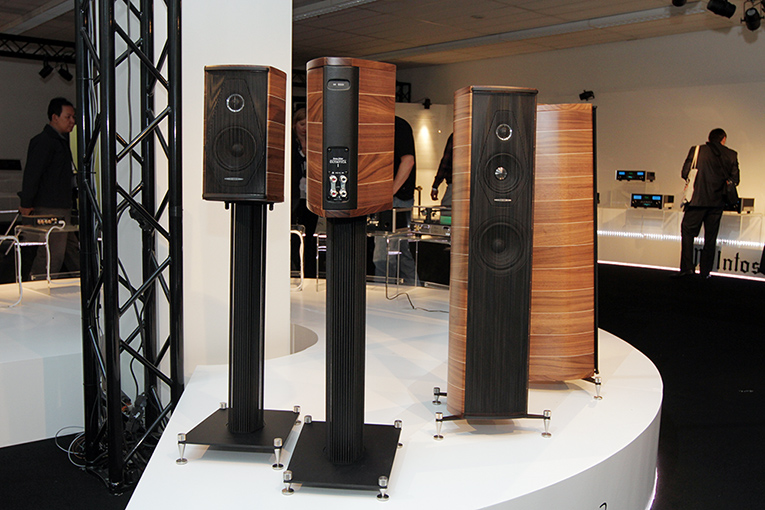
The newly rejuvenated Sonus Faber seems to do no wrong lately. They debuted the awesome Aida at CES 2012, the cost-effective Venere series later last year, and the attractive new Olympica series at High End 2013. The Olympica I is a stand-mounted design, the II and II are floorstanders, and they’re respectively priced at €4700, €7500, and €10,100/pair.
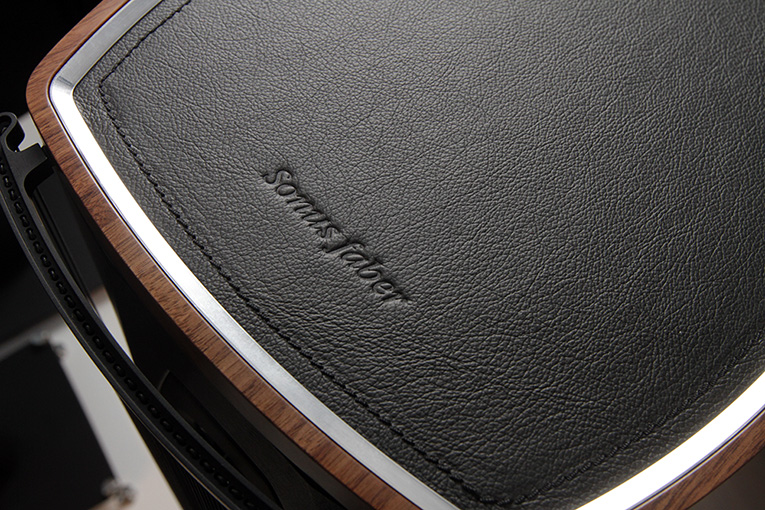
The three speakers we photographed weren’t playing, but two things stood out about these designs: 1) They’re the first speakers to use drivers made and designed entirely by Sonus Faber, the credit for that going to Paolo Tezzon, their chief acoustical designer. 2) They’re good looking. I mean really good looking -- as in Cindy Crawford, Helena Christensen, Claudia Schiffer, Revlon-era supermodel good looks. The speakers’ shapes are eye-catching, their woodwork is some of the best I’ve seen outside of Sonus’s more expensive models, and the attention to cosmetic details such as chrome and leather trim add a luxury appeal that I’ve seen in no other speakers near these prices. For marrying traditional audiophile speaker design to luxury styling and bling, Sonus Faber is at the top of the heap.
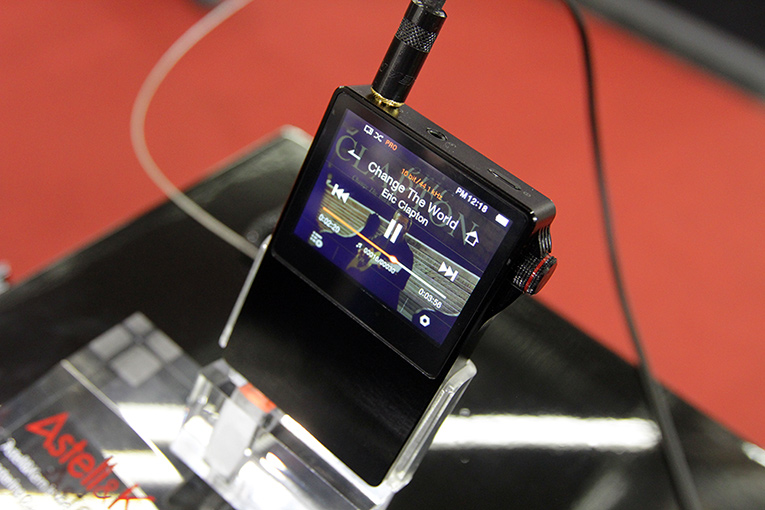
Say “portable music player” to most people and they’ll likely think iPod. They also might think “obsolete,” given that today’s smartphones double as players. So if you tell them about a player that’s brand new, made in Korea, not from Apple, and costs €1300, they’re likely to think you’re crazy for even mentioning it.
That’s what I thought when I heard about Astell&Kern’s new AK120 portable music player, which features two Wolfson DACs and can support all major music files with up to 24-bit/192kHz resolution. But skepticism turned to admiration the moment I saw, felt, and heard it. Based on a quick listen at A&K’s booth, this sturdy little all-aluminum device sounded superb. I also really like the side-mounted volume control, which reminded me of an oversized watch crown and made it seem like more than a little music player -- it felt like a real hi-fi component. Plus, the AK120 can support up to 192GB of storage space: 64GB inside, and two slots for microSD cards of capacities up to 64GB.
The jury is out on whether anyone actually needs a portable player of this caliber and cost, but it’s possible we do and just don’t know it yet -- I have to give A&K a high-five for producing such an ambitious product squarely aimed at enthusiasts of serious sound. I wish many other companies were so daring -- it’s what makes hi-fi fun.
Best systems
I was more impressed with the individual products shown at High End 2013 than with the systems. I didn’t hear many systems whose sound I really liked, and there was nothing that absolutely blew me away, as there has been in previous years -- I’m not sure why. Still, some systems were very good indeed.
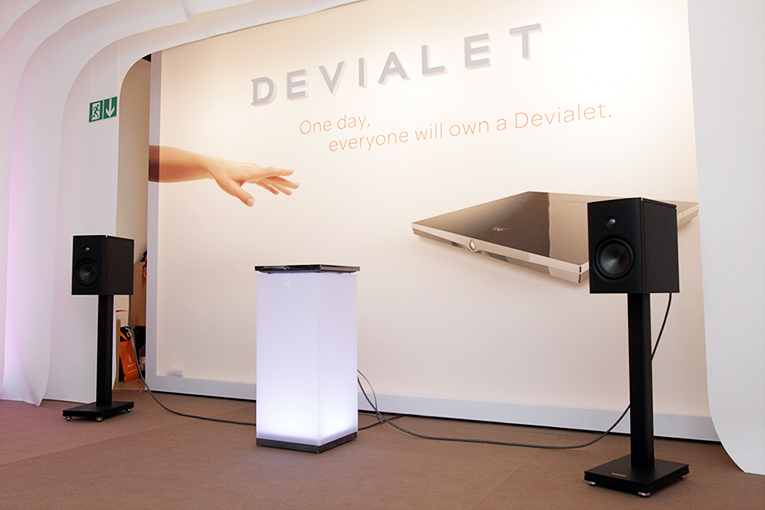
Devialet used Magico’s Q1 speakers ($26,600 including stands), Absolute Creations speaker cables, and a MacBook Pro to showcase its sweet-spot amplifier, the 170 (€6990). The system’s sound was appealing -- tonally accurate, highly detailed, and superclean, with more-than-respectable bass -- but so, too, was its appearance and compactness. The latter was partly due to the small sizes of the components, but mostly to the fact that the 170 packs a digital preamp, DAC, and proprietary power amplifier into one super-low-profile case. To me, this minimalistic, super-simple system represents the future of luxury, high-end hi-fi for smaller living spaces.
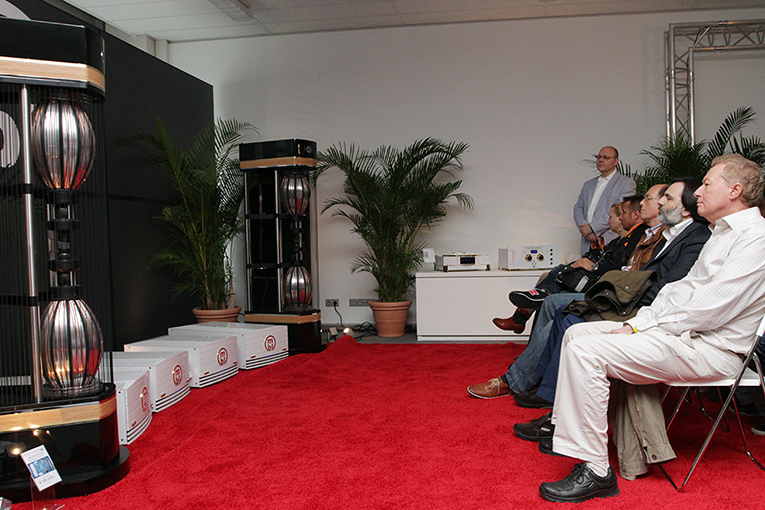
At the other end of the spectrum was MBL’s maximally complex system centered on their enormous 101 X-Treme loudspeakers, which sell for a mind-boggling €190,000/pair and need a very large room to sound good in. MBL was driving the 101 X-Tremes with four of their Reference 9011 monoblock power amplifiers (€39,000 each). I didn’t catch the model names of the other MBL components in the system, but it’s safe to say that the total list price was somewhere around €500,000, which would make it one of the most costly systems at High End 2013, if not the costliest.
Normally, such supersystems don’t appeal to me -- their size, cost, and complexity make them relevant to a mere handful of ultrawealthy audiophiles worldwide. Plus, they rarely sound good to me; in fact, most sound appalling. But this one was different, and I suspect that had largely to do with two things: it was an all-MBL system -- i.e., components that were designed to work well together -- and MBL has used this same room for several years, and knows its acoustics well.
No matter what music MBL played through the system, the sound was fully fleshed out, highly detailed, and consistent in tone, no matter where I was in the room -- a consistency that had to do with the 101 X-Treme’s 360-degree radiation of sound. But it was a piano recording that stopped me in my tracks and thoroughly convinced me that I should talk about this system in this article. That piano sounded more real than anything else I heard at High End 2013.
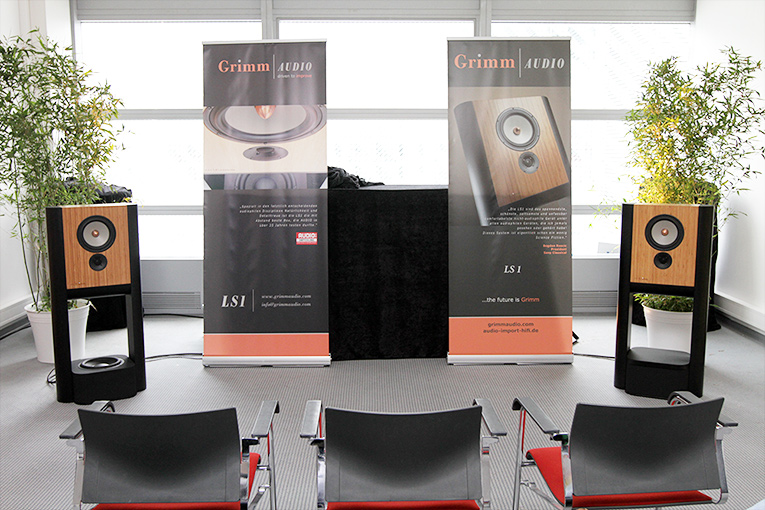
As I mentioned above, I think that Grimm Audio’s fully active, DSP-based LS1 represents the future of loudspeaker design -- in time, many speakers will be made this way. It’s also the pinnacle of system simplicity in terms of setup: attach a digital source and you’re ready to roll. Given that, its price of €21,000/pair doesn’t seem too unreasonable, because other than that source component, you don’t need to buy anything else. And the LS1’s sound was one of the most impressive I heard at High End 2013.
It didn’t take me long to figure out that the LS1 approached, and maybe attained, full-range performance in the bass (i.e., extension to 20Hz). As fellow-writer Roger Kanno likes to say, “They can pound.” They were also exceedingly neutral and clear, with dynamic capabilities that belied their modest size, and with very good soundstaging and imaging. The only fly in the ointment was a top end that sometimes sounded just a little “hot,” though I can’t be confident that that wasn’t more the fault of the room -- many of the systems in similar rooms sounded bright. All in all, this direction in loudspeakers proves that technology in service of the sound can result in something decidedly superior to what’s been offered in the past.
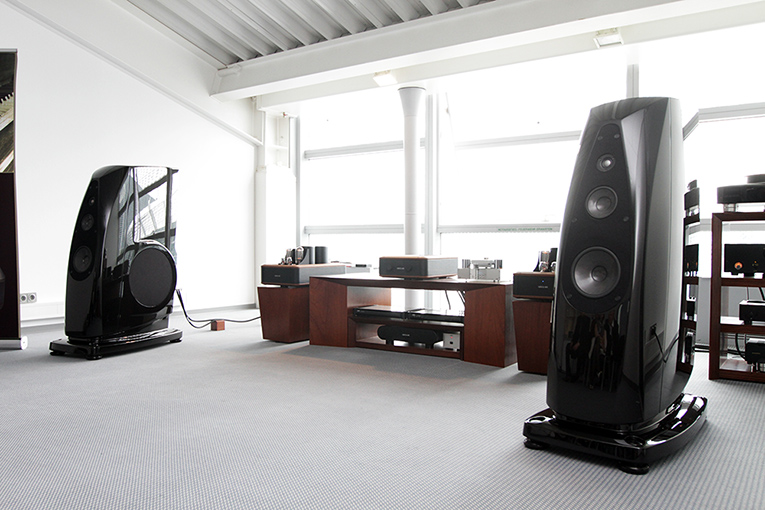
The best overall sound I heard at High End 2013 was from a system whose creators have taken a decidedly old-school approach in terms of number of components (lots), and matched them in a way I never thought would work well. The Absolare room contained a system that surprised me: Absolare makes a low-powered, monoblock tube amp, the Passion, that sells for $37,500 each and is said to deliver up to 52W of power. The matching Passion preamp costs $25,000. They were using Rockport Technologies Altair II loudspeakers, which sell for about $100,000/pair and hardly seem the kind of speakers that can be strapped to low-powered tube amps, given that they’re a four-way design with some colossal woofers; in fact, low-powered tubes are about the last things I’d consider driving the Altairs with. But the folks at Absolare proved me wrong.
Other than a little bit of midbass bloom, which obscured the lower registers a tad and might have been attributable to the amps, but might have had as much to do with the room or speaker placements, the sound was the best I’d heard from the Altairs outside the last place I heard them: the listening room of their designer, Andy Payor. They sounded full-range, exceptionally detailed, very refined, and with a midrange purity and palpability that were exceedingly natural and truly alive. I believe that the quality of the midrange had mostly to do with the Absolare electronics, because I’ve never heard the Altairs sound quite like that with solid-state amps. They were also playing some dynamic material pretty darn loud -- but the amps didn’t seem to be straining at all.
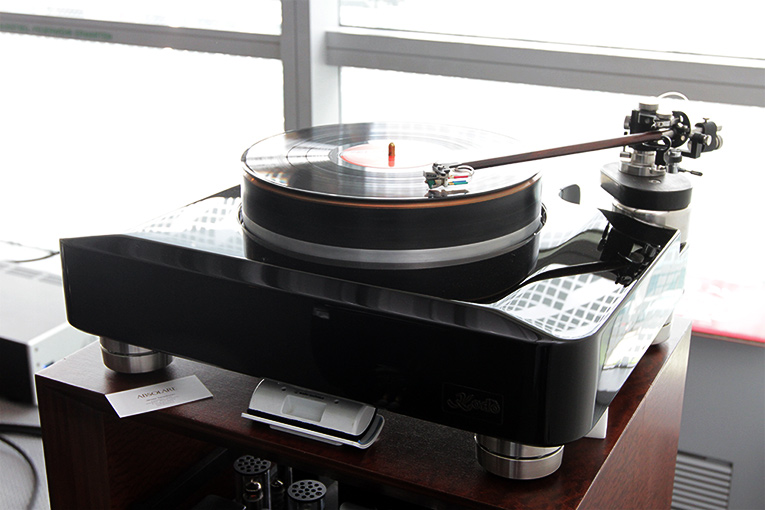
Other components in this system included digital electronics by MSB and C.E.C.; a Koda The Beat turntable with a Reed 3P tonearm, Lyra Atlas cartridge, and Allnic Audio H-3000 phono stage; Echole speaker cables, interconnects, and power cords; and some other stuff I missed. The total bill approached $500,000, which will leave 99.9% of the world’s audiophiles standing on the sidelines, admiring from afar and not even considering buying -- but it produced a sound that wasn’t just special, but the best I heard at High End 2013.
Now that the spring audio-show season is over, the “Best of” series gets put on the back burner for a while. But that’s not the end of the product talk -- watch this space for next month’s “My Favorite Products of 2013 So Far.”
. . . Doug Schneider
das@soundstagenetwork.com






















